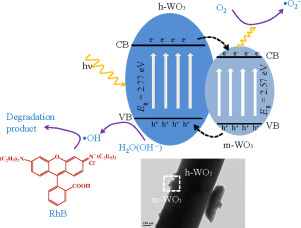
A series of WO3 samples with different crystalline phases were prepared by the thermal decomposition method from ammonium tungstate hydrate. X-ray diffraction (XRD), scanning electron microscopy (SEM), high-resolution transmission electron microscopy (HRTEM), X-ray photoelectron spectroscopy, and N2 adsorption-desorption were used to characterize the crystalline phase, morphology, particle size, chemical composition, and surface area of the WO3 samples. The formation of hexagonal (h-WO3) and monoclinic (m-WO3) crystal structures of WO3 at different temperatures or different times was confirmed by XRD. m-WO3 is formed at 600 °C, while m-WO3 starts to transform into h-WO3 at 800 °C. However, h-WO3, which forms at 800 °C, may transform into m-WO3 by increasing the calcination temperature to 1000 °C. SEM results indicate that m-WO3 particles exhibit a bulky shape with heavy aggregates, while h-WO3 particles exhibit a rod-like shape. Moreover, m-WO3 crystals are sporadically patched on the surface of the h-WO3 rod-like particles, resulting in the exposure of both m-WO3 and h-WO3 on the surface. It is observed that the monoclinic phase (m-WO3)/hexagonal phase (h-WO3) junction was fabricated by tuning the calcination temperature and calcination time. The relative ratios between m-WO3 and h-WO3 in the phase junction can readily be tailored by control of the calcination time. The photocatalytic activities of WO3 with different crystalline phases were evaluated by the photocatalytic degradation of rhodamine B as a model pollutant. A higher photocatalytic activity was observed in the WO3 sample with the m-WO3/h-WO3 junction as compared with the sample with only m-WO3. The improvement of photocatalytic activity can be attributed to the reduction of the electron-hole recombination rate owing to the formation of the phase junction, whose presence has been confirmed by HRTEM and photoluminescence spectra. Chinese Journal of Catalysis Volume 37, Issue 3, March 2016, Pages 349–358 |

